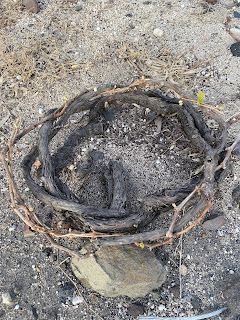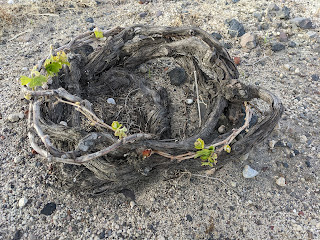


Left and center: Grape vines in Santorini showing the basket shape or kouloura.
Right: A field of vines near Akrotiri, Santorini.
Immediately upon arriving on the island of Santorini we notice it. In a taxi on our way up to Thira (Firà) at the crater's edge, we see fields that looked burned, with dead plants. We knew they were probably grapes, but the forms were so odd that we aren't sure.
The next day, near Akrotiri, we stop to walk into a field for a closer look. That's when we clearly see they are grapevines but coiled around themselves in a sort of basket form.It's still early in the season, well before leaves come out, so that explains the lack of green. And the soil of Santorini is a mix of light pumice gravel, sand, and black lava stone. From a distance it can look as if the field was freshly burned, which explains the scorched look. That leaves the question of the shape of the vines.
After some research, we discover that the pruning system used, and pictured here, is called kouloura (meaning "coil", "basket", or "wreath"). The vines rest on the ground and with successive wrapping of the vine back on itself in a coil, a hollow center is created. In the center, grapes grow sheltered from the intense Aegean winds and the vine collects any moisture available in the morning or evening dew and funnels it to the roots. These are dry vineyards – no water is added – so it's all about protecting the fruit from excessive heat and gathering enough moisture to keep the vine alive. (Only the youngest vines may be watered to get them started.)
The basket or wreath vines shown in this post are still quite young. Search for kouloura and you'll see some fantastically shaped vines. There is another pruning technique known as koulouri or klada, where grape canes are shaped into a large hollow cookie which hangs almost vertically over the ground. We didn't see these.
Santorini is home to the oldest continuously farmed vineyards in the world. Furthermore, the volcanic soils protected the vines from phylloxera epidemic of the late 19th century, which devastated European rootstock.
Also surprising to us from Italy was the story of vinsanto or Santorini wine, not to be confused with Vin Santo – the Italian dessert wine. In 2002, the European Union named Santorini, Greece as Vinsanto's place of origin thus granting the island exclusive rights to the use of the name Vinsanto on its sweet wines. Italy may still use vin santo or vino santo to denote its winemaking style.
The varieties of grape typically grown in Santorini are white varieties assyrtiko, athiri, and aidani, and red varieties mandilaria and mavrotragano.
Some references reviewed for this post:
Also, see our companion post Doors of Santorini Greece and the Cycladic Blue and White.
The basket or wreath vines shown in this post are still quite young. Search for kouloura and you'll see some fantastically shaped vines. There is another pruning technique known as koulouri or klada, where grape canes are shaped into a large hollow cookie which hangs almost vertically over the ground. We didn't see these.
Santorini is home to the oldest continuously farmed vineyards in the world. Furthermore, the volcanic soils protected the vines from phylloxera epidemic of the late 19th century, which devastated European rootstock.
Also surprising to us from Italy was the story of vinsanto or Santorini wine, not to be confused with Vin Santo – the Italian dessert wine. In 2002, the European Union named Santorini, Greece as Vinsanto's place of origin thus granting the island exclusive rights to the use of the name Vinsanto on its sweet wines. Italy may still use vin santo or vino santo to denote its winemaking style.
The varieties of grape typically grown in Santorini are white varieties assyrtiko, athiri, and aidani, and red varieties mandilaria and mavrotragano.
Some references reviewed for this post:
- Wikipedia Santorini wine
- The Art of Food and Wine
- The Amazing Wreath Vines of Santorini, Greece
- Wines of Greece: The Santorini "kouloura"
- Santorini Explained: Kouloura (Basket) vs Kladeftiko (small ring) – some interesting videos on pruning are here.
- The Big Blue (PDF)
Also, see our companion post Doors of Santorini Greece and the Cycladic Blue and White.



Examples of grape vines in Santorini trained in a basket shape called kouloura.
No comments:
Post a Comment
All comments are moderated. If your comment doesn't appear right away, it was likely accepted. Check back in a day if you asked a question.